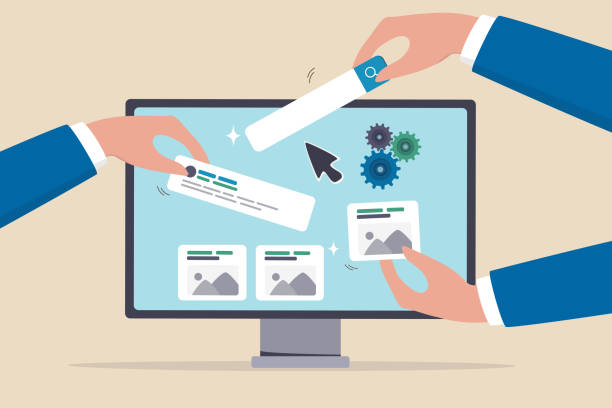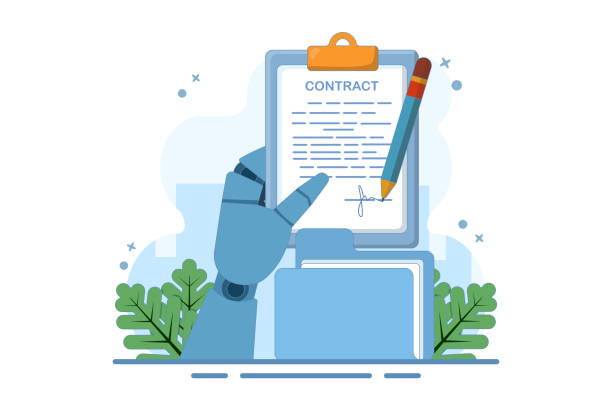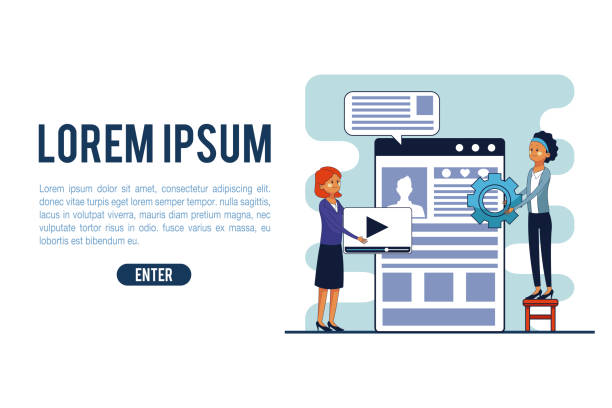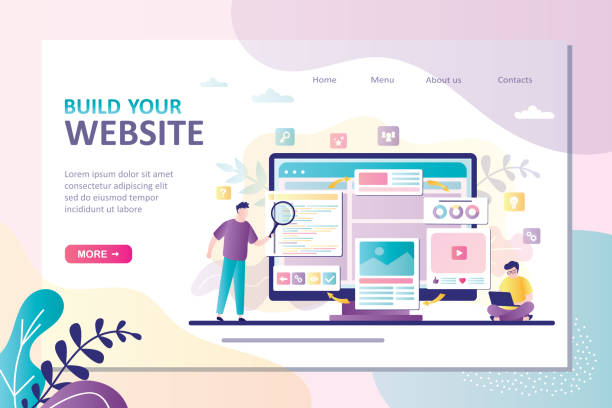An Introduction to the Importance of Modern User Interface Design

In today’s digital world, where competition is at its peak, modern user interface website design is no longer a luxury choice but an undeniable necessity.
Today’s users expect to interact with platforms that are not only visually appealing but also offer a smooth, intuitive, and frictionless user experience.
Failure to address this can lead to high bounce rates and the loss of potential customers.
A #modern_user_interface goes beyond aesthetics; it means deeply understanding users’ needs and expectations and providing intelligent solutions to meet them.
This approach becomes critically important, especially in an era where user attention is quickly fragmented.
Therefore, investing in modern user interface website design means investing in the future of your business and ensuring its sustainability in a competitive market.
Disappointed with your e-commerce site’s low conversion rate? Rasaweb transforms your e-commerce site into a powerful tool for attracting and converting customers!
✅ Significantly increase visitor-to-buyer conversion rates
✅ Unparalleled user experience to boost customer satisfaction and loyalty⚡ Get a free consultation from Rasaweb!
Key Principles of Modern User Interface Design

To achieve a modern user interface website design, one must adhere to a set of principles and rules that enhance the user experience.
The first principle is simplicity and clarity.
The user interface should be designed so that users can easily find the information they need and interact with different sections of the site.
Removing unnecessary elements and focusing on the main content significantly contributes to this clarity.
The second principle is consistency and integration; meaning design and interactive elements throughout the site should be uniform to prevent user confusion.
This includes consistent use of colors, fonts, icons, and navigation patterns.
Responsiveness is the third important principle.
Given the diversity of devices and screen sizes, the website must be designed to display correctly and function optimally on any device, from desktops to mobile phones and tablets.
This ensures that all users, regardless of the device they use, will have a positive user experience.
Finally, visual and interactive feedback is also crucial; the system should provide appropriate feedback to every user action (such as clicking a button or filling out a form) so that the user is aware of their status and feels in control.
These principles not only contribute to visual appeal but also maximize efficiency and usability.
Effective Tools and Technologies in Modern UI Design

Achieving a modern user interface website design requires the use of up-to-date tools and technologies.
In the realm of visual design and prototyping, tools such as Adobe XD, Figma, and Sketch are highly popular.
These software programs enable rapid design, creation of interactive prototypes, and team collaboration.
Figma, due to its cloud collaboration capabilities, has become a top choice for distributed teams.
These tools help designers quickly transform their ideas into prototypes and receive necessary feedback.
From a technical and implementation standpoint, front-end frameworks like React, Angular, and Vue.js play a key role in building dynamic and interactive user interfaces.
These frameworks, by providing reusable components and defined architectural structures, accelerate the development process and organize coding.
The use of Design Systems such as Google’s Material Design or Ant Design also helps maintain consistency and speed up the process of modern user interface website design.
These systems offer a set of guidelines, components, and ready-made patterns that prevent dispersion and inconsistency in design.
| Tool Name | Primary Use | Key Feature |
|---|---|---|
| Figma | UI Design, Prototyping, Team Collaboration | Cloud-based and Real-time Collaboration |
| Adobe XD | Web and Mobile Design, Prototyping, Animation | Integration with other Adobe products |
| Sketch | Vector Design, User Interface | Strong Plugin Ecosystem (Mac only) |
| InVision | Prototyping, Feedback Collection, Project Management | Collaboration and Workflow Tools |
The Impact of Modern UI Design on User Experience

Implementing modern user interface website design directly impacts the overall user experience (UX) and can make a significant difference in a website’s success.
A modern user interface, by reducing unnecessary complexities and improving interactive pathways, enables users to complete their tasks faster and with greater ease.
This leads to increased user productivity and reduced frustration.
When a user can achieve their goal on the site without problems or confusion, they will feel more satisfied and successful.
Furthermore, modern UI design, by focusing on aesthetics and visual appeal, helps reinforce the website’s trust and credibility.
A professional and up-to-date site becomes synonymous with quality and trustworthiness in the user’s mind.
This is especially critical for businesses, as customers are more likely to interact with and purchase from platforms that look professional.
Also, a modern and responsive user interface increases conversion rates because users have a positive experience on different devices and are more likely to take the desired action (such as signing up or making a purchase).
Ultimately, by providing an outstanding user experience, modern user interface website design helps foster customer loyalty and encourages users to return to your site more frequently.
Does your current website reflect your brand’s credibility as it should? Or does it drive away potential customers?
Rasaweb, with years of experience in designing professional corporate websites, is your comprehensive solution.
✅ A modern, beautiful website tailored to your brand identity
✅ Significant increase in lead generation and new customer acquisition
⚡ Contact Rasaweb now for a free corporate website design consultation!
Recent Trends in Web User Interface Design

The world of modern user interface website design is constantly evolving, and each year we witness the emergence of new trends that enrich users’ visual and interactive experience.
One prominent trend is minimalism.
This approach focuses on simplicity, ample white space, clear typography, and limited visual elements to highlight content and minimize distractions.
Minimalist design is often accompanied by faster website performance.
Another trend is the increasing popularity of Dark Mode.
Many users prefer to use this mode in low-light environments, as it reduces eye strain and provides a more modern visual experience.
Additionally, the use of subtle animations and micro-interactions to create visual feedback and greater engagement is expanding.
These animations are not only beautiful but can also help guide the user and improve their understanding of the site’s functionality.
3D design and Neumorphism are other visual trends that strive to create a sense of depth and realism in the user interface.
These trends represent a continuous effort to improve modern user interface website design and harmonize it with changing user expectations.
Challenges of Implementing a Modern User Interface

While modern user interface website design offers many benefits, its implementation also comes with challenges.
One of the most important challenges is maintaining optimal performance alongside visual appeal.
Modern user interfaces often include animations, high-quality images, and complex effects that can slow down website loading and disrupt the user experience, especially on older devices or with slow internet connections.
How can a balance be struck between visual attractiveness and loading speed? This is a question that design and development teams must answer.
Another challenge is ensuring Accessibility.
A modern user interface must be usable by all users, including those with disabilities.
This means paying special attention to aspects such as sufficient color contrast, screen reader support, and keyboard navigation.
Unfortunately, sometimes in prioritizing visual appeal, accessibility principles are overlooked.
Also, managing user expectations, which are constantly increasing with rapid advancements in the web domain, is itself a major challenge.
Users quickly adapt to new features and expect every website they visit to provide a similar or even better experience.
This continuous pressure for innovation engages design teams to stay up-to-date and offer the best solutions for modern web UI design.
Case Studies of Successful Modern User Interface Design

Looking at companies that have succeeded in modern user interface website design can be inspiring and guiding.
Companies like Apple have always been pioneers in providing visual and intuitive user interfaces.
Their website, with its focus on large product images, ample white space, and simple navigation, provides an unparalleled user experience.
Apple’s website design is a prime example of effective minimalism that focuses on the product and the main message.
Another successful example is music streaming platforms like Spotify.
Their user interface, with its default dark mode, strong visual content organization, and advanced personalization features, allows users to easily find their favorite songs and podcasts and have an enjoyable listening experience.
Building a website with a modern UI at Spotify demonstrates how a user interface can effectively present rich and complex content in a simple and understandable way.
These examples prove that by focusing on actual user needs and leveraging modern design principles, websites can be created that are not only beautiful but also highly successful in attracting and retaining users.
| Website/Platform | Successful UI Aspect | Impact on User |
|---|---|---|
| Apple.com | Minimalism, High-quality images, Intuitive navigation | Luxury user experience, Product focus, Simplicity |
| Spotify | Dark mode, Visual content organization, Personalization | Easy content access, Immersive listening experience |
| Airbnb | User-friendly booking interface, Large images, Interactive maps | Simple booking process, Travel inspiration |
| Stripe | Clean and professional design, Clear documentation | Trust and credibility, Ease of use for developers |
Practical Steps to Achieve Modern UI Design

To successfully implement modern user interface website design, a systematic approach must be followed.
The first step is deep user research and understanding.
This includes creating personas, User Journey Mapping, and conducting Usability Testing.
Understanding your audience helps you shape the design based on their actual needs and expectations.
The second step is ideation and Wireframing.
In this stage, initial layouts and site scaffolding are created without focusing on visual details, to define the overall structure and interaction flow.
After that, it’s time for visual design.
This involves selecting an appropriate color palette, fonts, icons, and graphic elements that create a modern and attractive visual identity.
At this stage, attention to the harmony and consistency of visual elements across the site is crucial.
The fourth step is building interactive prototypes.
These prototypes allow designers and stakeholders to simulate user interactions and get feedback before actual coding begins.
Finally, after completing the design and prototype, it’s time for front-end development and implementing the design into code.
Throughout all these stages, continuous feedback and iterative design based on it are essential for optimizing the web user interface and ensuring the final product’s quality.
Don’t have a corporate website yet and missing out on online opportunities? With a professional corporate website design by Rasaweb,
✅ Double your business’s credibility
✅ Attract new customers
⚡ Free consultation for your corporate website!
The Future of User Interface Design and the Impact of Emerging Technologies

The future of modern user interface website design is intertwined with rapid advancements in technology.
Artificial Intelligence (AI) and Machine Learning (ML) will play an increasingly important role in personalizing user interfaces.
Websites will be able to dynamically adjust the user experience based on past user behavior, preferences, and even emotions.
This will lead to interfaces that actively anticipate and respond to user needs, rather than merely reacting.
Furthermore, Voice User Interfaces (VUIs) and Augmented Reality (AR) are also shaping the future of UI design.
With the increasing use of voice assistants like Siri and Alexa, designing voice interactions has become an important area.
Also, AR technologies enable creating a seamless user experience with modern design in the real world and offer richer visual experiences that go beyond the two-dimensional screen.
These changes mean that UI designers must expand their skills and become familiar with new technologies to design interfaces that are not only beautiful and efficient but also compatible with emerging modes of human interaction.
These developments drive user interface design towards a more complex but much more exciting direction.
Conclusion and Future Outlook for Modern UI Website Design

Ultimately, modern user interface website design is more than a technical or aesthetic aspect; it’s a key strategy for effective user engagement and ensuring success in the digital space.
As we’ve seen, there are numerous principles and tools to achieve this goal, and attention to details such as simplicity, responsiveness, and accessibility is crucial.
Challenges exist, but with careful planning and staying up-to-date with current trends, they can be overcome.
Looking to the future, developments such as artificial intelligence and augmented reality promise smarter and richer user interfaces.
These developments show that the field of UI design is constantly dynamic and innovative.
For businesses and developers, continuous investment in improving and modernizing their website’s user interface not only attracts and retains customers but also strengthens their position in the competitive market.
In an era where user experience is paramount, designing digital platforms with advanced user interfaces has become more important than ever and will serve as the backbone of any online business’s success.
Frequently Asked Questions
| Row | Question | Answer |
|---|---|---|
| 1 | What is meant by “modern user interface website design”? | It refers to designing a website that uses the latest trends and best practices in user experience (UX) and user interface (UI) to make user interaction simple, engaging, and efficient. |
| 2 | Why is a modern user interface important for a website? | A modern user interface increases user satisfaction, improves conversion rates, extends user retention time on the site, and creates a professional and up-to-date brand image. |
| 3 | What are the key elements of a modern user interface? | Key elements include simplicity and minimalism, responsiveness, use of white space, attractive typography, subtle animations, an appropriate color palette, and intuitive navigation. |
| 4 | What role does responsiveness play in modern UI design? | Responsiveness ensures that the website displays correctly on any device (mobile, tablet, desktop) and provides a seamless user experience, which is essential for modern UI. |
| 5 | How important is typography in modern user interface design? | Typography plays a very important role in readability, visual hierarchy, and brand visual identity. Modern fonts and their combinations can contribute to the overall beauty and attractiveness of the site. |
| 6 | How are animations and micro-interactions used in modern design? | Animations and micro-interactions are used to create visual feedback, guide the user, and add a sense of dynamism and engagement to the user interface, provided they are not excessive. |
| 7 | What is the role of user experience (UX) in modern UI design? | UX is the foundation of modern UI. A modern design must first be functional, understandable, and enjoyable (UX), and then beautiful and attractive (UI). |
| 8 | What tools are used for modern user interface design? | Tools such as Figma, Adobe XD, Sketch, and InVision are used for design, and frameworks like React, Vue.js, or Angular are used for implementation. |
| 9 | How can overly complex design be avoided in a modern user interface? | By focusing on minimalism, removing unnecessary elements, using ample white space, and adhering to the principle of “Less is More.” |
| 10 | What is the importance of user testing in modern user interface design? | User testing ensures that the designed user interface is truly useful, understandable, and engaging for users, and that potential problems are resolved before launch. |
And other services of Rasaweb advertising agency in the field of advertising
Smart Link Building: An effective tool for user engagement through user experience customization.
Smart Advertorials: An innovative service for increasing sales through user experience customization.
Smart Social Media: A professional solution for customer acquisition with a focus on precise audience targeting.
Smart Digital Branding: A specialized service for growth in customer acquisition based on precise audience targeting.
Smart Brand Identity: Designed for businesses seeking digital branding through the use of real data.
And over hundreds of other services in the field of internet advertising, advertising consultation, and organizational solutions
Internet Advertising | Advertising Strategy | Advertorials
References
Professional Web Design
Principles of User Interface and User Experience Design
User Interface Design Training
What is User Experience?
? Are you ready for your business to shine in the digital world? Rasaweb Digital Marketing Agency, by offering comprehensive solutions including fast website design and professional services from SEO to content marketing, helps you achieve your goals. Experience a powerful and impactful online presence with us.
📍 Tehran, Mirdamad Street, next to Bank Markazi, Southern Kazeroun Alley, Ramin Alley No. 6

